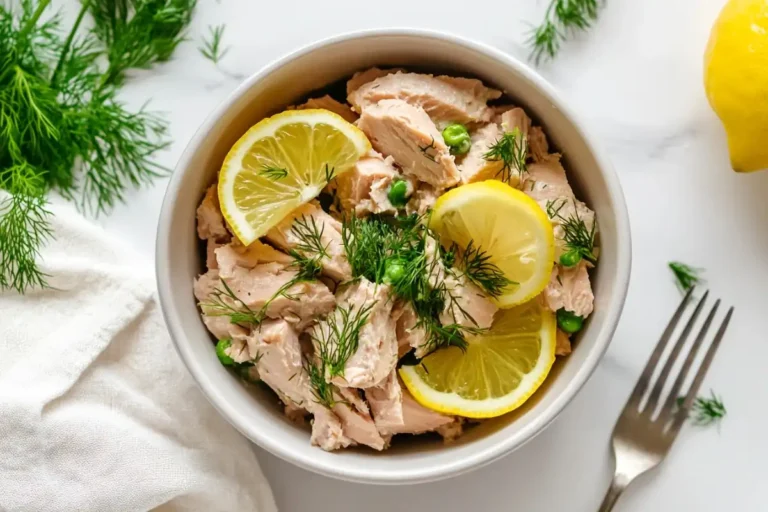The Magic Behind Martha Stewart’s Tuna Salad
If you’ve ever craved a fresh, flavorful twist on a classic dish, Martha Stewart Tuna Salad delivers every time. Let’s talk tuna salad. If you’re wondering what makes Martha Stewart Tuna Salad so brilliant, it’s all about fresh ingredients and thoughtful additions. This recipe transforms a humble dish into something unforgettable. Martha has this incredible knack for taking humble ingredients and turning them into something unforgettable. Her tuna salad? It’s the perfect example of how a few thoughtful additions can make a dish sing. But what makes her version stand out in a sea of tuna salads? Let’s dive in.
Why Tuna Salad Is a Timeless Favorite
Tuna salad has been around forever—or at least since the early 20th century, when canned tuna became a pantry staple. There’s just something magical about its simplicity: creamy, tangy, and satisfying, all wrapped up in one easy-to-make dish. Whether you’re spreading it on toast, stuffing it in a tomato, or eating it straight from the bowl, it hits the spot every time.
But why does this dish remain so beloved? For starters, it’s endlessly adaptable. You can keep it traditional with mayo and celery or jazz it up with gourmet twists like capers or fresh herbs. Additionally, tuna salad is high in protein, making it a go-to option for anyone looking for a quick and healthy meal. It’s also a nostalgic dish, reminding many of family lunches or picnic spreads.
Who Is This Recipe Perfect For?
Martha Stewart’s tuna salad is for anyone who appreciates simple elegance in their meals. If you’re the type who loves recipes that feel a bit gourmet but are still easy to make, this one’s for you. It’s perfect for:
- Busy folks who want a quick, satisfying lunch.
- Entertainers looking for a crowd-pleasing appetizer (hello, tuna salad crostini!).
- Health-conscious eaters who want a protein-packed dish without too many calories.
- Nostalgic souls craving a modern twist on a classic comfort food.
The Unique Appeal of Martha’s Culinary Approach
Martha Stewart’s recipes are all about quality over quantity. She knows that the best dishes don’t require a million ingredients—just the right ones. Her tuna salad reflects this philosophy, combining simple components in a way that feels fresh and flavorful. Moreover, she incorporates little touches that elevate the dish, like using freshly squeezed lemon juice and high-quality olive oil
The Secret to Her Signature Flavor
So, what’s Martha’s secret? It’s all about balance. She doesn’t just rely on mayo to bring the creaminess—she also uses mustard for a tangy kick and fresh herbs for brightness. The result? A tuna salad that’s rich but never heavy, with layers of flavor in every bite.
A Brief History of Tuna Salad Recipes
Tuna salad has been a lunch counter favorite since the early 20th century, as explained in this comprehensive history of canned tuna. Its origins date back to the early 1900s, when canned tuna first became widely available. By the 1920s, tuna salad sandwiches were a lunch counter staple. Over time, the recipe evolved, incorporating everything from hard-boiled eggs to pickles and even apples.
How Martha Stewart’s Version Stands Out
What makes Martha’s recipe unique is her focus on freshness. Instead of relying solely on pantry staples, she incorporates ingredients like fresh dill and lemon zest to give the salad a bright, zesty flavor. It’s a subtle twist that takes this classic dish to the next level. Martha Stewart Tuna Salad is unique because of its focus on fresh ingredients, like dill and lemon zest.
Ingredients in Martha Stewart’s Tuna Salad
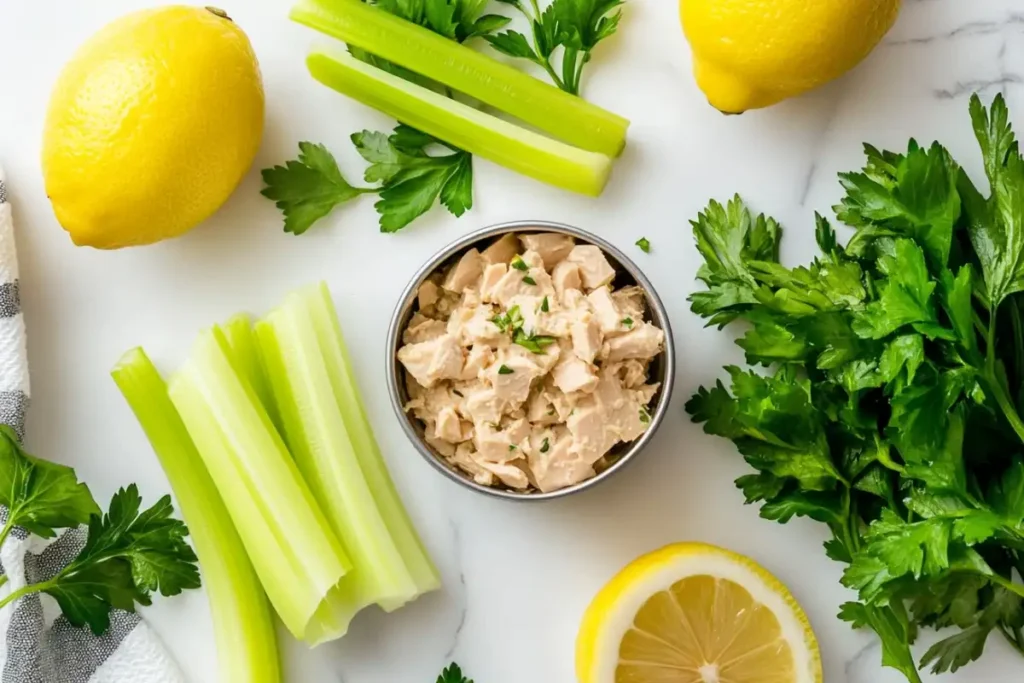
If you’ve ever wondered what Martha Stewart puts in her tuna salad to make it so special, it all starts with carefully chosen ingredients. She takes something as humble as tuna and elevates it (oops—makes it extraordinary!) with fresh, flavorful additions that keep things interesting yet uncomplicated. Here’s a breakdown of the essential ingredients and why they work so well together.
Choosing the Best Tuna: Fresh vs. Canned
Let’s settle this first: fresh or canned? While fresh tuna sounds fancy, it’s not always practical for a quick salad. Martha typically opts for high-quality canned tuna, specifically solid white albacore. Why? It’s tender, flavorful, and blends beautifully with the other ingredients. Plus, it’s convenient. However, if you’re feeling adventurous or want a gourmet spin, you can use poached fresh tuna. Canned tuna is convenient and nutritious, making it a versatile option for many dishes, including healthy snacks.
Here’s a quick tip: look for tuna packed in olive oil. It adds a richness you just don’t get with water-packed varieties. If you only have the latter, drain it well and mix in a little olive oil before proceeding.
Key Add-Ins: What Gives the Salad Its Unique Taste
Now, this is where Martha’s recipe really shines. She doesn’t just throw in mayo and call it a day. Instead, she layers in fresh, vibrant flavors that elevate the dish. Some of the key add-ins include:
- Fresh lemon juice: Brightens the overall flavor and cuts through the creaminess.
- Dijon mustard: Adds a subtle tang and depth of flavor.
- Herbs (like parsley or dill): Fresh herbs bring a pop of green and a garden-fresh vibe.
- Celery: For that classic crunch we all love.
- Red onion: A mild, slightly sweet bite that complements the richness of the tuna.
These ingredients work in harmony, creating a salad that’s anything but ordinary. Fresh lemon juice and Dijon mustard are quick and easy ways to add bold flavors, similar to other 10-minute lunch recipes.
The Role of Lemon Juice and Herbs
When it comes to building flavor, lemon juice and herbs are non-negotiable. The acidity from the lemon juice balances the richness of the mayo, making the salad feel lighter. Meanwhile, fresh herbs like dill or parsley add an earthy, aromatic quality that elevates every bite.
Pro tip: If you don’t have fresh herbs on hand, a small pinch of dried dill can work in a pinch. Just be sure to use it sparingly—dried herbs are more potent than fresh ones!
Balancing Flavors with Mustard and Mayo
Here’s the thing: too much mayo can make a tuna salad feel heavy, while mustard can be overpowering if overused. Martha’s secret? She combines the two in just the right proportions. The mayo provides creaminess, while the mustard adds a zingy sharpness. The result is a balanced, flavorful base that complements the tuna without overwhelming it.
For those watching their calorie intake, you can swap some of the mayo for Greek yogurt. It’s tangy and creamy, and you probably won’t even miss the extra mayo.
Step-by-Step: How to Make Martha’s Tuna Salad
Let’s get to the fun part—making the salad! Follow these simple steps, and you’ll have a Martha-approved tuna salad in no time.
Prepping the Tuna for Maximum Flavor
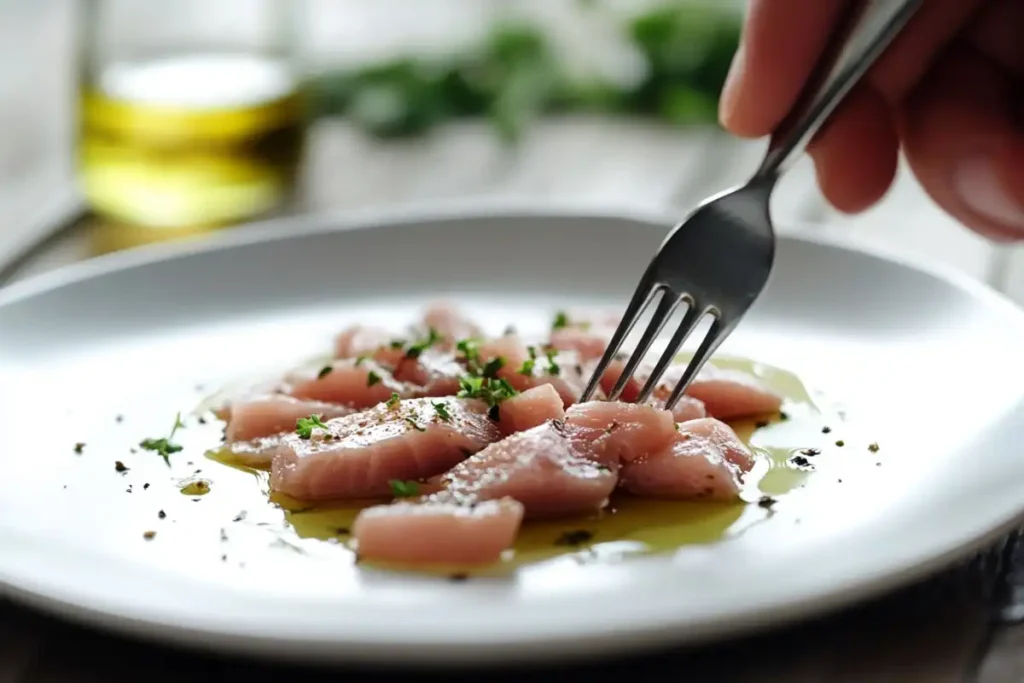
- Choose the right tuna: As mentioned earlier, solid white albacore packed in olive oil is ideal. If you’re using water-packed tuna, drain it thoroughly and mix in a teaspoon of olive oil for added flavor.
- Flake the tuna: Use a fork to break the tuna into small, even flakes. This ensures every bite is well-coated with the dressing.
Mixing and Layering for the Perfect Texture
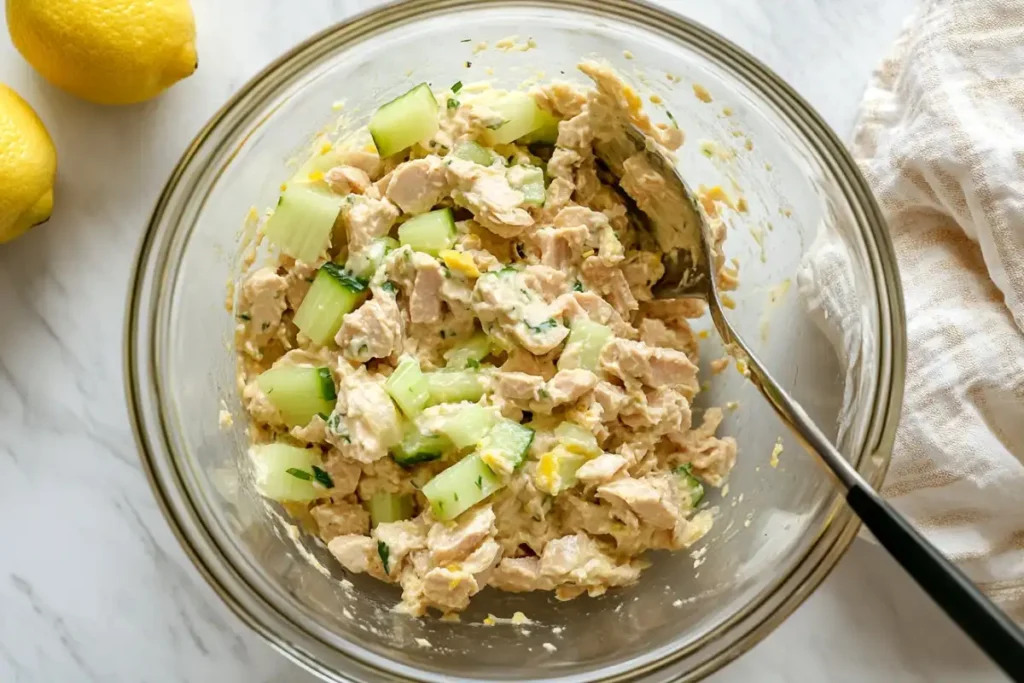
- Start with the dressing: In a mixing bowl, combine mayonnaise, Dijon mustard, and fresh lemon juice. Whisk until smooth.
- Add the crunch: Toss in finely chopped celery and red onion for texture.
- Fold in the tuna: Gently mix the tuna into the dressing, being careful not to over-mix—it should still have some texture.
- Finish with herbs: Sprinkle in freshly chopped dill or parsley and stir until just combined.
Nutritional Breakdown of the Dish
If you’re wondering whether this dish is healthy, the answer is a resounding yes—especially if you use high-quality ingredients. Here’s a quick nutritional breakdown for one serving of Martha’s tuna salad (approximately 1 cup):
- Calories: 250
- Protein: 30g
- Fat: 12g (mostly from healthy olive oil and mayo)
- Carbohydrates: 3g
- Fiber: 1g
With its high protein content and low carb count, Martha Stewart Tuna Salad is a fantastic option for those following a balanced diet.
Tips for Elevating Martha’s Tuna Salad Recipe
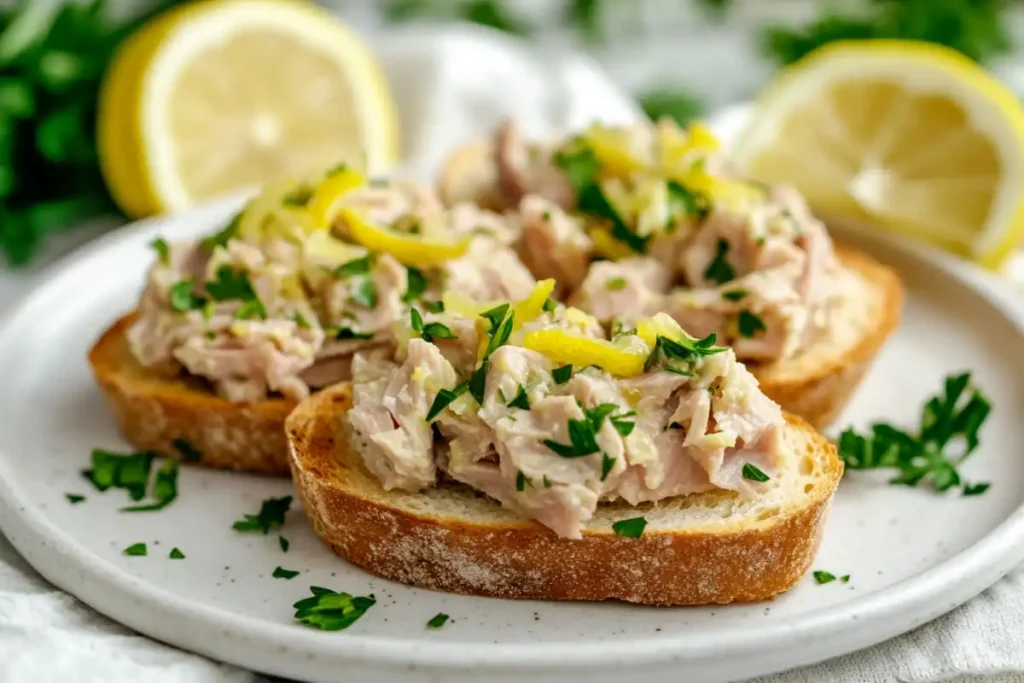
If you’re already a fan of the classic recipe, Martha Stewart Tuna Salad offers endless ways to personalize and elevate the dish. For instance, you can add bold spices or experiment with different proteins to suit your taste. Moreover, the possibilities truly feel endless when you let your creativity shine. Adding variety to your tuna salad makes it a great option for quick lunches and fits seamlessly into meal prep ideas.
Customizing the Recipe to Your Taste
Not a fan of red onion? Swap it out for scallions. Want more crunch? Throw in some diced bell peppers. If you’re feeling adventurous, try adding:
- Capers: For a salty, briny twist.
- Chopped pickles: Adds tang and texture.
- Hard-boiled eggs: Boosts the protein and makes the salad even heartier.
The beauty of tuna salad is its flexibility—it’s easy to tailor to your preferences without losing its charm.
How Does Martha Stewart’s Tuna Salad Compare?
When it comes to tuna salad, Martha Stewart isn’t the only household name with a killer recipe. Comparing hers to other versions out there, like Paula Deen’s or Gordon Ramsay’s, gives you a deeper appreciation for how subtle changes in ingredients and techniques can transform this classic dish. Martha’s tuna salad is all about fresh, balanced flavors, but how does it stack up against other culinary heavyweights?
Exploring Paula Deen’s Take on Tuna Salad
Paula Deen, known for her love of Southern comfort food, has her own spin on tuna salad. It’s rich, creamy, and undeniably indulgent—pretty much what you’d expect from a Paula Deen recipe. However, there are some key differences between her approach and Martha’s.
Key Differences in Ingredients
While Martha keeps things light with lemon juice and fresh herbs, Paula leans into richness. Her version often includes:
- Hard-boiled eggs for added protein and creaminess.
- Sweet pickle relish for a pop of tangy sweetness.
- More mayonnaise—because, well, it’s Paula.
On the other hand, Martha’s use of Dijon mustard and olive oil keeps her salad feeling fresh and modern.
Which Recipe Is Easier to Make?
Here’s the thing: Paula’s recipe is a bit more involved, especially if you’re adding eggs or making it in large batches. Martha’s, with its minimal ingredients and straightforward method, is quicker to whip up. If you’re in a time crunch but still want a flavorful dish, Martha’s recipe wins hands-down.
Similarities That Both Recipes Share
Despite their differences, both recipes have a few things in common:
- Both use high-quality tuna as the base.
- Both include crunchy elements like celery or onions.
- Both can be served in versatile ways—on bread, crackers, or even lettuce wraps.
Ultimately, whether you choose Paula’s or Martha’s recipe depends on what you’re craving: bold and creamy or light and zesty.
Why Does Restaurant Tuna Salad Taste Better?
Have you ever wondered why tuna salad from a restaurant seems to have that extra something? Well, it’s not magic—it’s all about attention to detail. For example, chefs take time to select top-notch ingredients and use professional techniques. As a result, every bite is perfectly balanced and spot-on.
The Importance of Quality Ingredients
Restaurants often use tuna packed in high-grade olive oil, which makes a huge difference in flavor. They also don’t skimp on fresh add-ins, like crisp vegetables and fragrant herbs. And let’s not forget that perfectly ripe lemons can make or break the dressing.
Techniques Used by Professional Chefs
Chefs know how to layer flavors for maximum impact. For example, they might marinate the tuna in olive oil and lemon juice before mixing it with the other ingredients. They also pay attention to texture, ensuring the salad isn’t too mushy or dry.
Pro tip: If you want to replicate restaurant-quality tuna salad at home, try seasoning the salad in stages and tasting as you go. A pinch of salt or a squeeze of lemon at the end can make all the difference.
How Gordon Ramsay’s Tuna Salad Stacks Up
Gordon Ramsay’s take on tuna salad is, unsurprisingly, bold and sophisticated. Known for his high-energy cooking style, Gordon’s version adds a gourmet twist to this humble dish.
A Breakdown of His Ingredients
Ramsay’s tuna salad often features:
- Seared fresh tuna steaks instead of canned tuna.
- A mix of greens like arugula for a peppery bite.
- A vinaigrette dressing instead of traditional mayo-based ones.
His approach is more of a composed salad than the classic scoop we’re used to, but it’s undeniably delicious.
Signature Methods That Elevate the Recipe
One of Ramsay’s signature moves is searing the tuna to perfection—crisp on the outside and tender inside. He also layers textures and flavors, combining creamy avocado with crunchy vegetables and tangy vinaigrette. While it’s not your typical tuna salad, it’s a refreshing departure for those looking to try something new.
FAQs About Martha Stewart’s Tuna Salad
How Do You Make Martha Stewart’s Tuna Salad?
To make Martha Stewart’s tuna salad, combine high-quality tuna, mayonnaise, Dijon mustard, fresh lemon juice, celery, and herbs like dill or parsley. Mix gently to maintain texture, and adjust seasoning to taste.
Can I Use a Substitute for Mayonnaise?
Yes! You can use Greek yogurt or mashed avocado as a substitute for mayonnaise. Both options provide creaminess and a slightly tangy flavor, keeping the salad light yet delicious.
What Type of Tuna Works Best?
Solid white albacore tuna packed in olive oil is the best choice for its rich flavor and tender texture. If using water-packed tuna, add olive oil for a similar result.
How Do I Store Leftover Tuna Salad?
Store leftover tuna salad in an airtight container in the refrigerator for up to 3 days. For best results, stir well before serving, as the dressing can separate slightly.
What Are Common Mistakes in Tuna Salad Recipes?
Overloading with mayo or skipping fresh ingredients like lemon juice are common mistakes. Balancing flavors and textures is key to creating a delicious tuna salad.
Can This Recipe Be Made Gluten-Free?
Absolutely! The recipe is naturally gluten-free as long as you avoid serving it with gluten-containing bread or crackers. Pair it with gluten-free options like lettuce wraps or rice cakes.
How Can I Add More Protein to the Salad?
Adding hard-boiled eggs or chickpeas is an easy way to boost the protein content. Both options blend well with the flavors and provide extra texture.

